| Operation Overlord |
Invasion of the French coast June 6, 1944 - D-Day
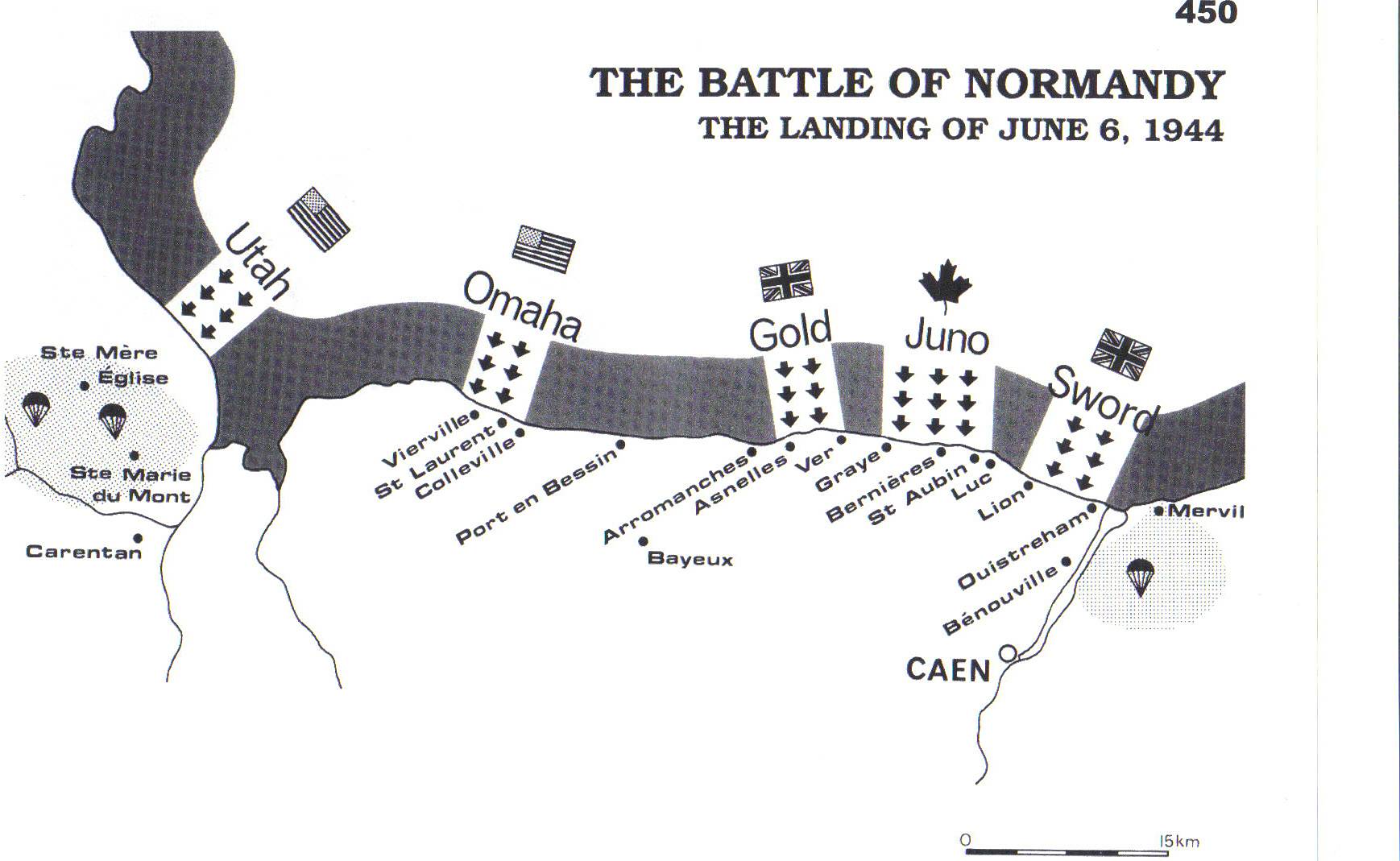
Invasion of the French coast June 6, 1944 - D-Day |
 |
|
Prelude
to cross channel attack
In
1940, after German forces began occupation of France, there was serious
concern that the United
States might be drawn into the war. Although President Roosevelt, echoing the position of the congress, was pledging to keep American boys from fighting in a foreign war, military planners were preparing for the worst. To this end, in mid 1940, an American naval officer, Rear Adimiral Robert Ghormle, was stationed in London to provide a channel for exchange of information with British authorities. The American presence, in observer status, changed abruptly in the hours following the Japanese attack on Pearl Harbor, and by Germany's declaration of war on the United States, which occured on December 11, 1941.
|
| Overlord
Date for the
Normandy landings was initially established when President Roosevelt,
Prime Minister Winston Churchil, and Soviet Leader Joseph
Stalin, met to discuss war strategy at Terhan, in November 1943.
The invasion was set for May 1944.
As the target date
approached,
it became evident that more time would be needed to assemble sufficient
equipment, especially assault landing craft. D-Day was set for the
morning of June 5th. On that day, with many troops already under
way, storm clouds accumulated across the English Channel. General Eisenhower
postponed the invasion for 24 hours. Finally, with assurance of a
weather window the following morning, Eisenhower, meeting with his
general staff, said” I don’t think we can postpone again, I
don’t like it but there it is. We’ll go!” Within
hours, paratroopers were in the air. It was just after midnight, June
6, 1944
|
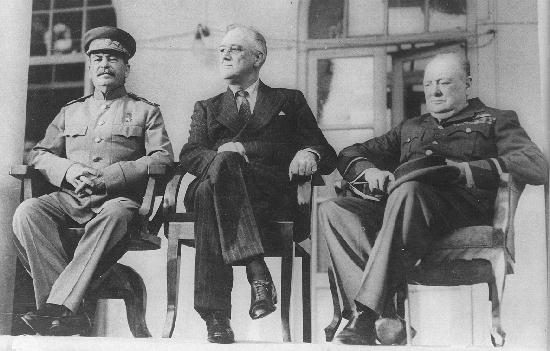 Soviet Leader Joseph Stalin, President Roosevelt and British Prime Minister Winston Churchill, meet at Teheran, Iran - November 28, 1943 |
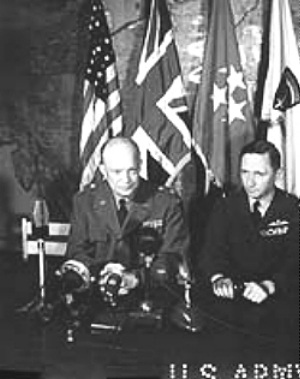 General Dwight D. Eisenhower Supreme Commander of all Allied forces June 6, 1944 |
Soldiers, Sailors and Airmen
of the Allied Expeditionary Force! "You are about to embark upon the Great Crusade, toward which we have striven these many months. The eyes of the world are upon you. The hopes and prayers of liberty-loving people everywhere march with you. In company with our brave Allies and brothers-in-arms on other Fronts, you will bring about the destruction of the German war machine, the elimination of Nazi tyranny over the oppressed peoples of Europe, and security for ourselves in a free world. Your task will not be an easy one. Your enemy is well trained, well equipped and battle hardened. He will fight savagely. But this is the year 1944! Much has happened since the Nazi triumphs of 1940-41. The United Nations have inflicted upon the Germans great defeats, in open battle, man-to-man. Our air offensive has seriously reduced their strength in the air and their capacity to wage war on the ground. Our Home Fronts have given us an overwhelming superiority in weapons and munitions of war, and placed at our disposal great reserves of trained fighting men. The tide has turned! The free men of the world are marching together toVictory! I have full confidence in your courage and devotion to duty and skill in battle.We will accept nothing less than full Victory! Good luck! And let us beseech the blessing of Almighty God upon this great and noble undertaking." SIGNED: Dwight D. Eisenhower |
|
Allied Expeditionary Forces Supreme Commander: General Dwight D. Eisenhower American British Naval Western Task Force Eastern Task Force Air Forces Eighth Air force Second Tactical Air force Ninth Air Force Assault Forces V Corps !st British Corps VII Corps 30th British Corps 1st Infantry Division 3rd Infantry Division 4th Infantry Division 6th British Airborne Div. 29th Infantry Division 50th British Airborne Div. 82nd Airborne Div. 3rd Canadian Infantry Div. 101st Airborne Di |
|
D-Day
The attack
commenced in the early morning hours of June 6, 1944, as two American
and one British Airborne Division dropped behind enemy lines.
First assault waves touched down at 630 hours on five beaches, over a
59mile front, from the Orne River in the east to the Cotentin
Peninsula at the western end of the landing zone American
Airborne
troops landed behind Utah beach while British airborne secured the
banks of the Orne River.
As
dawn approached, looking out to sea from the enemy positions, German
sentries saw an armada of over 5000 ships breaking over the horizon.
Preparatory
to troop landings, naval guns pounded beach defenses. Although Allied
bombers were active along the beaches, clouds and fog hampered
accuracy. As a result the softening up, that troops expected, was
considerably diminished. At 6:30 a.m. the first of 150,000 troops began
their assault. American troops landed at Omaha and Utah beaches while
the British and Canadians landed on Gold, Juno and Sword beaches.
|
Ike Arrived at the 101st assembly area unannounced . To minimize distractions, all insignias on his command car were covered. |
| Omaha
Beach The landing
by regiments of the 1st and 29th Infantry Divisions was much more
difficult that expected. First elements of the 29th, landing in the
vicinity of Vierville, came under a hail of gunfire from towering
bluffs overlooking the beach. Since the Air strikes had not been fully
successful due to heavy cloud cover, German troops had ample time to
take up positions in concrete bunkers. On the 29th’s right,
Rangers began to scale the steep cliffs at Point Du Hoc to eliminate
the guns positioned there. Casualties mounted rapidly. The
consentrated fire all but stopped the 29th’s assault waves.
Second
wave reinforcements were diverted eastward where the initial waves
from the 1st Division were landing near the village of Saint Laurent
Sur Mur. By mid morning as, troops were still struggling to get across
Omaha beach alive, Lt. General Omar Bradley, upon receiving very bleak
reports in those early hours, considered abandoning Omaha and landing
troops elsewhere along the beach. Then, aided by gunfire from navy
ships steaming dangerously close to shore, individuals and small
groups, many leaderless, finally made it across the beach. The
attack began to materialize. By days end the V Corps had a small
lodgement area on Omaha beach.
|
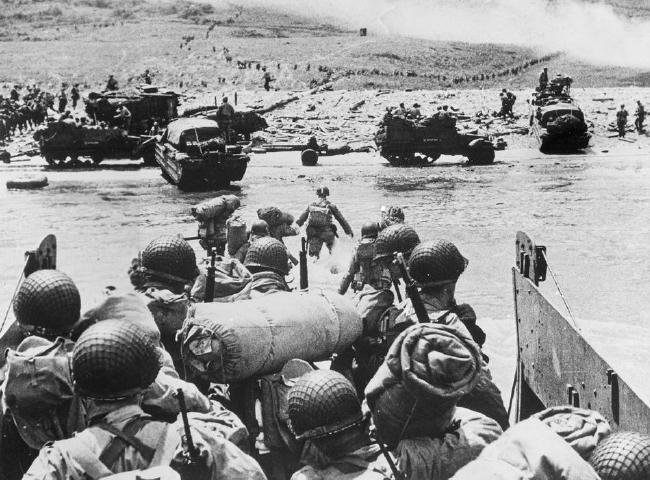 First
waves touch down at 6:30
hours amid a hail of machine gun, mortar and
artillery fire. Most men were
now seasick from the rough seas. Company A, 116th
Infantry Regiment, first in, was virtually destroyed in the first
few minutes
|
| Utah
Beach Further west, the VII
Corps was landing at Utah beach. Here the beach was
flat. This beach was considerably deeper than Omaha, and was not
as tightly defended. The initial problem for VII troops, led by
the 4th Infantry, was the extremely high waves and strong
winds
which forced many landing craft over 2000 yards from their target
zones.
After assessing the situation Brigadier General General Theodore
Roosevelt is reported to have said. “O.K. we’ll start the
war right here”
In
the meantime, further inland, in the Utah Beach sector the 82nd and
101st Airborne, who had jumped from planes that were dodging flak from
enemy
guns, were widely scattered, many missing drop zones altogether.
As
daylight
arrived small groups began to assemble. Although unnerving to the
troops, the scattered landings also made it impossible for the Germans
to develop adequate response. The had no idea where to set up defenses.
Although
the 4th Division’s casualties were light, compared to the
misfortune at Omaha, they had not reached their first day objectives by
nightfall. The lodgement was, however, sufficient to
resume the attack come daylight.
|
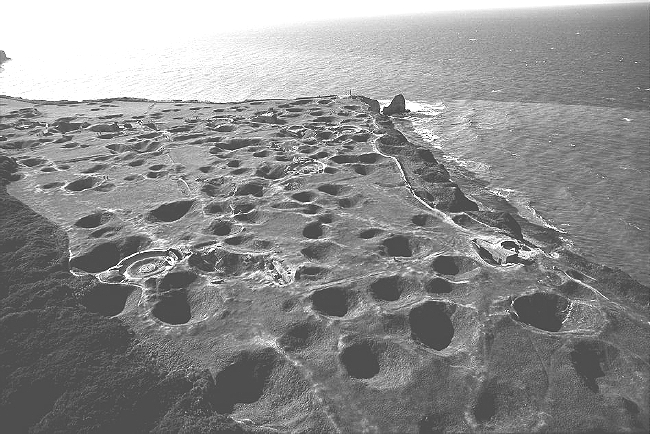 Point du Hoc between
Omaha and Utah beaches.The 2nd
Ranger
Battalion scaled the cliffs to take out German guns that
covered a wide area, only to find the guns had been moved
inland. This photo illustrates the reason why the guns were
moved. To fulfill their mission, rangers slipped in, located the
guns and destroyed firing capability without arousing the enemy.
These bomb craters remain on point du Hoc to this day.
|
| Gold,
Juno and Sword Beaches Immediately
to the left of Omaha, British and Canadian forces were landing on their
assigned beaches. The British 50th Infantry Division and 8th Armored
Brigade landing on gold beach encountered light resistance and by the
end of the day had advanced to the outskirts of Bayeux.
To their left, the First Canadian Infantry, supported by the 2nd Canadian Armored Brigade, came under heavy fire as they encountered a sea wall, much higher than that at Omaha. First waves suffered over 50 % casualties. By night fall, however, the Canadians had penetrated German defenses further than any of the other beaches. At the Orne River, on
the extreme left of the Overlord landings, the
British 3rd Infantry Division and the 27th Armored Brigade landed
quickly on Sword Beach with light casualties. German defenses
tightened however, as
they moved inland, thus, blocking the British short of the City of
Caen, their first day objective. By the end of the day,
Operation Overlord had placed over 100,00 troops firmly on shore. The
price had been high, as 9,000 American British and Canadian men lay
dead or wounded. History records that it
was the initative and heroism of the indiividual soldier that
ultimately secured the
landings on that eventful day!
As D- Day assault
forces were securing a foothold on
“Hitler’s Fortress Europe,”hundreds of military units
with thousands of GI’s were bivouacked along the English southern
coast, awaiting call to join the battle. Among
these was the American
XIX Corps, and within that Corps, the 82nd Engineer Combat Battalion.
Their call came 4 days later and on June 17th, first units of the
battalion came ashore at Omaha.
As first units of
the 82nd came ashore, heavy
weather was moving in. Within hours, all disembarkation was halted as
the storm intensiified. In succeding days, the storm wrecked
docks, sunk ships and tore up temporary shore
installations. For over a week Operation Overlord was in virtual
limbo. During this time troops struggled to hold ground already
taken. As July approached the war was back on track. St. Lo was
captured on July 18th , breakout from the hedgerows took place on
on July 25th. Now, it was just a matter of time!
____________________________ |
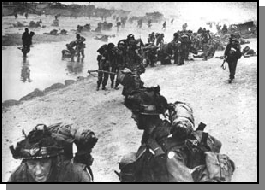 British Troops come ashore on Sword Beach June 6, 1944 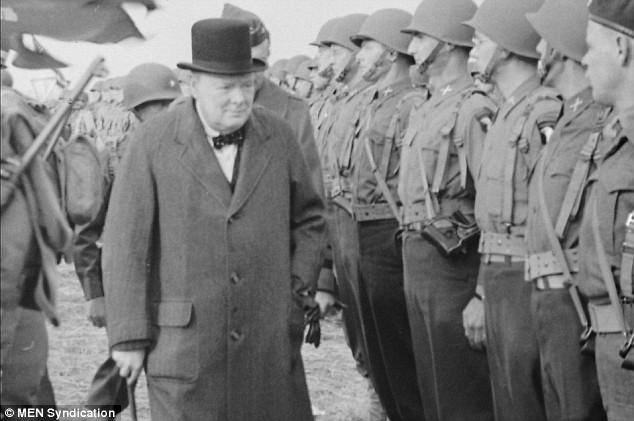 Prime Minister Churchill inspects American Troops before embarkation - 1944 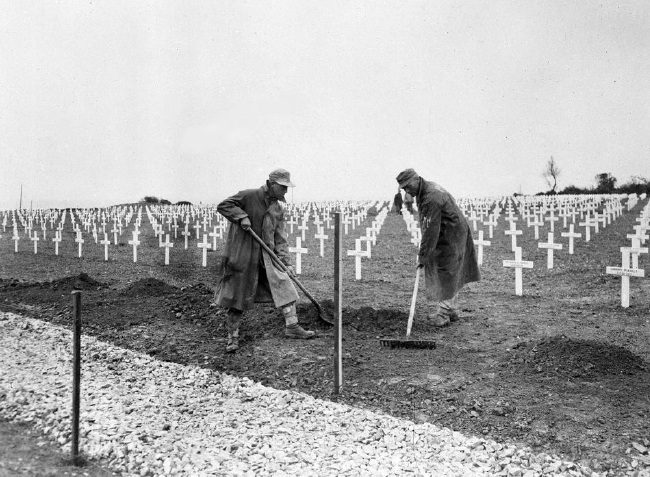 First temporary cemetary in Normandy - workers are German P.O.W's |
| Describing the Overlord
Mission, in summary fashion, as I have, might convey the
image of a simple military exercise to the reader. Quite to the
contrary, combat forces would spend the next ten months living in the
ground, constantly under fire from enemy guns, seeing the death of
comrades daily, and most of the time dirty and hungry. Any combat
soldier will attest to the misery of war! The success of Overlord was a beginning! Bringing the European campaign an end would require another 335 continuous days of fighting, with thousands more to be added to the casualty count! |